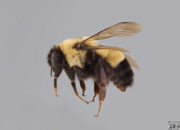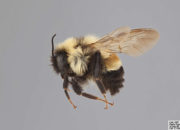Formerly common throughout eastern North America, but populations crashed in late 1990’s. Apparently extirpated from Vermont since about 1999, but a few populations still exist in the Midwest and Virginia. Federally Endangered.
Specimen photos in the grid are courtesy of Margarita Miklasevskaja at PCYU with funding from NSERC-CANPOLIN.
Historically, Rusty-patched Bumble Bees ranged from Minnesota east to Maine and as far south as Georgia. Recent surveys, however, show an extreme contraction of the species’ range with only isolated patches remaining in Midwestern and Northeastern states. It was last observed in Vermont in 1999.
Although the exact cause of this crash is uncertain, introduced parasites from imported colonies and pesticide use appear to be two major culprits. During the 1990s, to more successfully pollinate certain commercial crops, greenhouses across the United States began importing species of American bumblebees that had been reared in Europe. Having been exposed to foreign pathogens for which most native species had evolved no resistance, the imported bumble bees escaped the greenhouses and infected bees in surrounding areas. In addition, pesticides used to control other insect species also kill bumble bees. Even small amounts used on lawns and in gardens can negatively impact entire colonies.
Identification: See Xerces Society material for detail identification information.
Similar Species: Brown-belted Bumble Bee (Bombus griseocollis), Tricolored Bumble Bee (Bombus ternarius), Half-black Bumble Bee (Bombus vagans)
Global Status: Imperiled (G2)
Vermont Status: Possibly Extirpated (SH)
For more information, visit the following links:
Discover Life
Living Atlas Species Page
Distribution: Historically widespread in Vermont, currently only known from a few areas of the Midwest and Appalachian Mountains. To see the global distribution, check out the iNaturalist account, and toggle the GBIF layer on the map.








